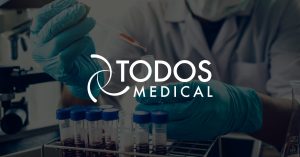There is cause for even more optimism on the COVCID-19 front. The anti-viral medication, Tollovir is showing great promise not only with preventing people with SARS-CoV-2 infections from progressing to a critical state but also in reversing acute symptomology in patients that are in critical care. Manufactured by Todos Medical (OTCMKTS: TOMDF), Tollovir functions differently than its closest current competitor, molnupiravir, created by Merck.
While molnupiravir disrupts the life cycle of the coronavirus by forcing it to replicate genetic errors, Tollovir takes a different therapeutic route by targeting by blocking the 3CL protease, the main proteinase identified by scientists with regard to coronavirusus in general, and SARS-CoV-2 in particular. By blocking 3CL protease, Tollovir prevents viral proteins from forming, which stops replication in its tracks. Additionally, Tolloivir is the only anti-viral that specifically targets the widespread inflammatory reponses, known as the cytokine storm, in the most critically ill patients.
This is a crucial component when it comes to combatting COVID-19 infections because when some people become infected with SARS-CoV-2, their immune systems overreact, setting up a hyper-inflammatory response throughout their body known as the “cytokine storm.” Although doctors and scientists disagree on the exact definition of a cytokine storm, there is broad agreement that it is characterized by “systemic inflammation, and multiorgan dysfunction that can lead to multiorgan failure if inadequately treated,” according to The New England Journal of Medicine.
Given that 20%–30% of patients hospitalized with COVID-19 develop complications associated with the cytokine storm, Tollovir could be a game-changer. In the most current phase 2 trials, Tollovir significantly reduced both the range of days people were hospitalized as well as the mean duration, or the average number of days. Furthermore, there were no deaths associated with hospitalized patients receiving Tollovir, as compared to five deaths in the placebo group.
Moreover, Tollovir is made with natural ingredients, giving it a safer side-effect profile. As Benzinga reports, “It has been administered to 5,000 people, and the ingredients it’s made of (botanical extracts) have been deemed safe for widespread use by multiple regulatory agencies worldwide, including the FDA.” Tollovir is also considered safer because it does not cause mutations of human genes, something that is a risk with medications such as molnupiravir.

As Benzinga points out, “Because of the mutational risk, Merck’s trial warned enrollees not to have unprotected intercourse while on the drug.” Another concern associated with drugs like molnupiravir is that they may promote the creation of viral variants, thereby potentially extending the pandemic. Yet, there is no solid data to back up that hypothesis.
A word of caution is in order, however. While the data from the Tollovir trials have been nothing short of impressive, the sample size thus far for Tollvirs trials is very small, capping out at 77 subjects. When the Todos cites the 5,000 sample size, they are actually referring to the use of its botanical-derived product, Tollovid, which is currently available online. Although the ingredients in Tollovir and Tollovid are very similar, the 5,000 sample size refers to the safety studies, not the efficacy of the ingredients in Tollovir.
Still, a more naturally-created medication that can treat both moderately and acutely ill SARS-CoV-2 infections is a significant achievement. The reality is that the more medications available to fight COVID-19, the better. That’s true for two reasons. First, everybody responds differently to pharmaceutical interventions. While some may respond better to molnupiravir, others may be better off with Tollovir.
Moreover, some people may have an allergic reaction to some of the underlying ingredients of a particular medication, so having options is important to prevent secondary complications. And, there will likely be a group of people that need Monoclonal antibodies or even convalescent plasma to fully recover. Consequently, treatment regimens are likely to emerge in which patients receive a combination of medication therapies structured around the severity of their symptomology, medical history, and potential interactions with medications they are currently taking.
Secondly, having multiple medication therapies increases competition amongst pharmaceutical manufacturers, which not only reduces cost in the long run but pushes innovation in the field as a whole. As more robust information emerges from both clinical trials and empirical data, the best medications will hopefully break out from the pack. Also, as patents expire, these medications will ultimately become generic, further driving down their costs.
Yet, all of these advances force an essential question out into the public forum: Why was there a lack of scientific focus on treatments for COVID-19 from the beginning?
I want to be clear on this issue. I am a vaccinated person, and I believe everyone, short of having a true medical reason, should get a COVID-19 vaccine, though I stop short of federal mandates because I believe this may be a violation of our Constitutional rights, particularly with regard to the 10th Amendment.
But even as the federal government was daily pointing out the death toll from COVID-19, there was a lack of effort to find effective therapies for people who were hospitalized from the virus. As Shy Arkin, a professor of structural biochemistry at the Hebrew University of Jerusalem argues, “The US government poured huge amounts of resources on vaccine development and meager, if any, resources on drug development.”
There are reasons for my suspicion because there were already drugs that showed promise we could have been trying. For example, the medication darapladib, which was initially created by GlaxoSmithKline to treat atherosclerosis, but failed in Phase III trials, was a potential candidate.
Likewise for flumatinib, an anti-cancer drug that is currently only approved in China. According to The Hebrew University of Jerusalem, lab experiments “showed that the drugs can protect cells from onslaught by the virus with close to 100 percent effectiveness, meaning that almost 100% of the cells lived despite being infected by the virus.”
While these are lab-centered approaches that would need to be validated with double-blind placebo human trials, they indicate we may have had treatments right under our proverbial nose the whole time. I am not asserting any kind of nonsense to the effect that our federal government was intentionally ignoring potential therapeutics to kill off a chunk of our population, a theory that would require me to put on my tinfoil hat.
What I am saying is that the concerted federal effort to create a vaccine at the expense of interventional therapeutics was shortsighted, and may have cost lives in the short term. What was called for was a reimagining of Operation Warp Speed as a three-pronged approach to attacking COVID-19.
First, of course, would be the development of efficacious vaccines, something we did incredibly well. The second prong would be an highly coordinated approach to repurpose existing drugs. Although some research did take place along this front, it was mostly a regional or local dynamic, so it just felt like there was a lack of a coordinated, federally directed plan. Finally, the third approach would have been to support the creation of novel treatments. All three prongs should have had the full financial and human capital support of the federal government.
Perhaps the lack of a coordinated effort was caused by a sense of panic about the grim data as we witnessed hundreds of thousand of people dying from this devastating disease. Only time will reveal the real reasons.
Meanwhile, the fact that people now will have more weapons in this fight against COVID-19 is heartening.






